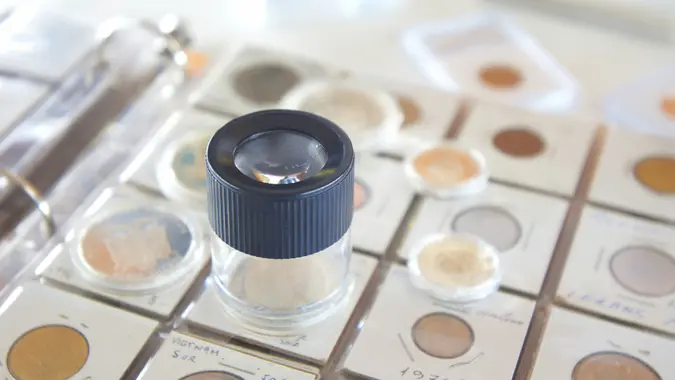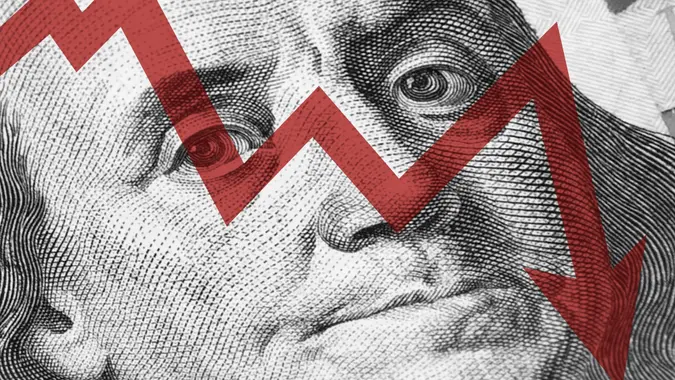Americans Largely Blame Government and Big Oil for Inflation as Over Half Dip Into Savings or Borrow Money

Commitment to Our Readers
GOBankingRates' editorial team is committed to bringing you unbiased reviews and information. We use data-driven methodologies to evaluate financial products and services - our reviews and ratings are not influenced by advertisers. You can read more about our editorial guidelines and our products and services review methodology.

20 Years
Helping You Live Richer

Reviewed
by Experts

Trusted by
Millions of Readers
The highest inflation rate in decades has affected virtually every single human being and every sector of the economy significantly. With the consumer price index data for May rising 8.6% over the past 12 months and 1% from April to May, it is no surprise that consumers have strong opinions on who is to blame for the current inflationary crisis and how it has impacted their spending habits.
The National Retail Federation’s (NRF) Consumer Views on Inflation survey of 2,000 American consumers was conducted between May 6 and May 10, 2022, and sought to engage buyers on how their purchase patterns have changed in the face of sky-high prices. It also tracked opinion on who has been responsible for the highest inflation rate in 40 years.
According to results of the NRF’s consumer inflation poll, 64% of respondents blamed the government for the current inflation crisis, with 54% specifically pointing to the government’s approach to policy and spending. Oil companies (42%), manufacturers (28%), banks (19%), retailers (15%) and restaurants (7%) round out the scapegoats.
Regardless of who or what is to blame, the impact on consumers’ shopping habits is considerable. Many polled have turned into thriftier consumers as a result of inflation.
When it comes to buying everyday necessities, many respondents are worried about how they are going to afford these basic items. Forty-seven percent of those surveyed are switching to cheaper product alternatives, 45% are seeking out sales and coupons, 41% are shopping at discount stores and are changing regular brands and 40% said they are cutting down on spending in other areas to afford necessities.
Not surprisingly, the most vulnerable in society have had a tougher time dealing with inflation’s blow to their finances. Of those individuals surveyed who make under $25,000 a year, 72% state they have to borrow money, go into debt or draw from their savings just to cover expenses. That number lowers to 58% for all consumers, across all income groups.
While survey respondents agreed with a number of NRF questions concerning the government’s role in addressing supply chain disruptions and lowering tariff taxes, the NRF listed a few specific recommendations that the Biden Administration should act upon to help ease inflation and help retail business get back on their feet immediately. These included passing the Ocean Shipping Reform Act of 2021, working on immigration policy reform and repealing Section 301 tariffs on Chinese goods to alleviate costs and prices for businesses and customers, respectively.
According to The Hill, the NRF has been lobbying for the last of these suggestions for a long time. In a letter to President Biden, NRF President Matthew Shay stated, “Consumers and businesses continue to feel the pain of higher prices across the board from everyday goods and services to rent and groceries and gas,” Shay wrote. “Removing the harmful China 301 tariff will alleviate some of the inflationary pressure on the U.S. economy.”
The NRF is the largest retail trade association in the world, representing and lobbying for America’s largest private-sector employer, which provides $3.9 trillion to the annual GDP, per its website.
More From GOBankingRates
- Nearly 1 in 3 Americans Hit by a Costly Holiday Scam, Norton Survey Shows -- How To Avoid This
- Here's What Retirees Wasted the Most Money On in 2025 -- and How To Avoid It in 2026
- How Middle-Class Earners Are Quietly Becoming Millionaires -- and How You Can, Too
- 6 Safe Accounts Proven to Grow Your Money Up to 13x Faster
 Written by
Written by  Edited by
Edited by 

























